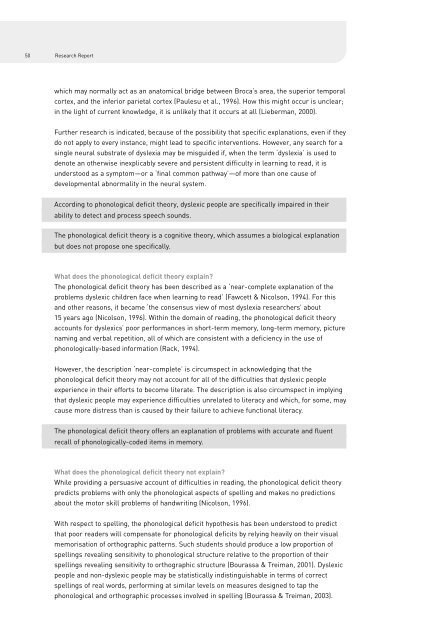01 NRDC Dyslexia 1-88 update - Texthelp
01 NRDC Dyslexia 1-88 update - Texthelp
01 NRDC Dyslexia 1-88 update - Texthelp
You also want an ePaper? Increase the reach of your titles
YUMPU automatically turns print PDFs into web optimized ePapers that Google loves.
50<br />
Research Report<br />
which may normally act as an anatomical bridge between Broca’s area, the superior temporal<br />
cortex, and the inferior parietal cortex (Paulesu et al., 1996). How this might occur is unclear;<br />
in the light of current knowledge, it is unlikely that it occurs at all (Lieberman, 2000).<br />
Further research is indicated, because of the possibility that specific explanations, even if they<br />
do not apply to every instance, might lead to specific interventions. However, any search for a<br />
single neural substrate of dyslexia may be misguided if, when the term ‘dyslexia’ is used to<br />
denote an otherwise inexplicably severe and persistent difficulty in learning to read, it is<br />
understood as a symptom—or a ‘final common pathway’—of more than one cause of<br />
developmental abnormality in the neural system.<br />
According to phonological deficit theory, dyslexic people are specifically impaired in their<br />
ability to detect and process speech sounds.<br />
The phonological deficit theory is a cognitive theory, which assumes a biological explanation<br />
but does not propose one specifically.<br />
What does the phonological deficit theory explain?<br />
The phonological deficit theory has been described as a ‘near-complete explanation of the<br />
problems dyslexic children face when learning to read’ (Fawcett & Nicolson, 1994). For this<br />
and other reasons, it became ‘the consensus view of most dyslexia researchers’ about<br />
15 years ago (Nicolson, 1996). Within the domain of reading, the phonological deficit theory<br />
accounts for dyslexics’ poor performances in short-term memory, long-term memory, picture<br />
naming and verbal repetition, all of which are consistent with a deficiency in the use of<br />
phonologically-based information (Rack, 1994).<br />
However, the description ‘near-complete’ is circumspect in acknowledging that the<br />
phonological deficit theory may not account for all of the difficulties that dyslexic people<br />
experience in their efforts to become literate. The description is also circumspect in implying<br />
that dyslexic people may experience difficulties unrelated to literacy and which, for some, may<br />
cause more distress than is caused by their failure to achieve functional literacy.<br />
The phonological deficit theory offers an explanation of problems with accurate and fluent<br />
recall of phonologically-coded items in memory.<br />
What does the phonological deficit theory not explain?<br />
While providing a persuasive account of difficulties in reading, the phonological deficit theory<br />
predicts problems with only the phonological aspects of spelling and makes no predictions<br />
about the motor skill problems of handwriting (Nicolson, 1996).<br />
With respect to spelling, the phonological deficit hypothesis has been understood to predict<br />
that poor readers will compensate for phonological deficits by relying heavily on their visual<br />
memorisation of orthographic patterns. Such students should produce a low proportion of<br />
spellings revealing sensitivity to phonological structure relative to the proportion of their<br />
spellings revealing sensitivity to orthographic structure (Bourassa & Treiman, 20<strong>01</strong>). Dyslexic<br />
people and non-dyslexic people may be statistically indistinguishable in terms of correct<br />
spellings of real words, performing at similar levels on measures designed to tap the<br />
phonological and orthographic processes involved in spelling (Bourassa & Treiman, 2003).
















